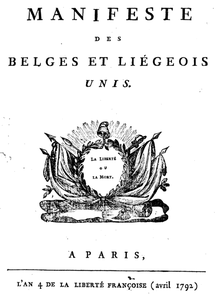Committee of United Belgians and Liégeois

The Committee of United Belgians and Liégeois (Dutch: Comité der Vereenigde Nederlanders en Luykenaers or Verenigd Comité der beide Natien, French: Comité (général) des Belges et Liégeois Unis) was founded in January 1792 in Paris by exiled rebel leaders from the failed Brabantine Revolution and Liège Revolution (August 1789 – January 1791) in modern-day Belgium.[1] The refugees exiled to France made efforts towards the liberation of the Austrian Netherlands and the Prince-Bishopric of Liège from Austrian Habsburg rule. They strove to establish an independent "Belgian" republic, modelled after the 1791 French Constitution, and put their hopes in French military aid to realise it.[2]
Goals
The Committee stated in its manifesto, the Manifesto of the United Belgians and Liégeois (published in French and Dutch), that although the desired revolution had failed, the next opportunity should be awaited to 'liberate the fatherland'. The Committee elaborated on why a revolution would be necessary: all citizens are equal and collectively have popular sovereignty. A constitution, largely based on the French Constitution of 1791, should guarantee this civil equality and sovereignty. Amongst other things, it contained a modified Declaration of the Rights of Man and of the Citizen, the most important state institutions of the Belgian Republic, a definition of citizenship, how a separation of powers was to be maintained and how elections of a representative assembly were to be organised. Furthermore, the Manifesto provided for the establishment of a 50 member Revolutionary Power, chosen from members of the Committee, which would conduct a provisional governance as soon as the revolution would have begun until the state institutions were formed and elections held.[2]
| Dutch Wikisource has original text related to this article: |
| French Wikisource has original text related to this article: |
The form of the new republic was imagined as follows:[2]
I. The Belgian, previously Austrian provinces, and the Land of Liège will in the future make up one single state, under the name of Belgian Republic.
II. This Republic will be a representative democracy: the representatives will be the Legislative Body and the Council.
III. Its territory will be subdivided into districts, and the districts into municipalities.
IV. All inhabitants of the Republic, which are considered to be active citizens according to the hereafter stipulated characteristics, will elect representatives to whom the nation will confide either legislative, or executive, or judicial power for a certain period of time.V. All active citizens who make up every district or municipality will have the right to, according to the manner which will be specified hereafter, elect from their midst the persons who will under the title of municipal magistrates or servants of the municipalities be burdened for a period of time with observing the specific interests of said districts and municipalities.
Lobby work in Paris
In the capital city of Paris, the Committee was an influential lobby group that was trying to persuade the leaders of the evolving French Revolution to invade the Southern Netherlands (since the mid-18th century increasingly called la Belgique in French – after ancient Gallia Belgica – instead of les Pays-Bas, but in Dutch still normally referred to as Nederland or de Nederlanden). The Committee had far-reaching influence on Minister of Foreign Affairs Charles-François Dumouriez, who, in the run-up to the War of the First Coalition (on 20 April 1792 declared on Austria), put great confidence in the Committee's assurances that the Belgians and Liégeois would spontaneously rise in rebellion against the Austrians as soon as French troops crossed the borders. In March 1792, Dumouriez stated to his fellow ministers:[3]
As soon as the French army enters the Belgian provinces, it will be helped by the people, who are ashamed of their own futile revolutionary efforts of [1789–1790]. They will join forces with our troops and will easily drive the dispersed hordes of Austrian mercenaries from their towns or scatter them. Paris will be defended on the banks of the Meuse. For the Country of Liège, the one most worthy of freedom of all those who have raised its flag, our negotiators will depart to dictate a wise peace, which we will under no circumstances spoil by the spirit of conquest.
Role in the War of the First Coalition
Such an uprising supported by France was prepared by the French government. The Liégeois revolutionary Pierre Henri Hélène Marie Lebrun-Tondu was appointed by Dumouriez as the coordinator of the Belgian-Liégeois operation in Paris, while Hugues-Bernard Maret functioned as the primary liaison with the revolutionaries in the Netherlands and Liège. Simultaneously, a Southern Netherlands/Liège army of exiles was formed in Lille under the name of Légion belge.[4] The Committee moved there, and in May, Maret was elected to chairman of the Committee. Together with Jan Frans Vonck, former leader of the Vonckists named after him, Maret concluded an agreement with the French government that it would arm and equip two legions of insurgents that would temporarily be part of the French army until the Austrian army's defeat, after which they would be transferred to the Committee, which would set up a provisional government of the would-be Belgian Republic.[4] Eventually, three Belgian corps and one Liégeois corps were formed which would battle the Austrians throughout 1792, jointly with the French.[5]
References
- ↑ Howe, Patricia Chastain (2008). Foreign Policy and the French Revolution: Charles-François Dumouriez, Pierre LeBrun, and the Belgian Plan, 1789–1793. New York: Palgrave Macmillan. p. 73–77. ISBN 9780230616882. Retrieved 28 July 2018.
- 1 2 3 Comité der Vereenigde Nederlanders en Luykenaers, Vertooning aen de Nederlandsche en Luyksche volkeren, van wegens en uyt den naem van 't vereenigd Comité der beyde Natien (Paris 1792).
- ↑ Howe, p. 70.
- 1 2 Howe, p. 74.
- ↑ Cook, Bernard A. (2004). Belgium: A History (3rd ed.). New York: Peter Lang. p. 48. ISBN 0-8204-7647-1.